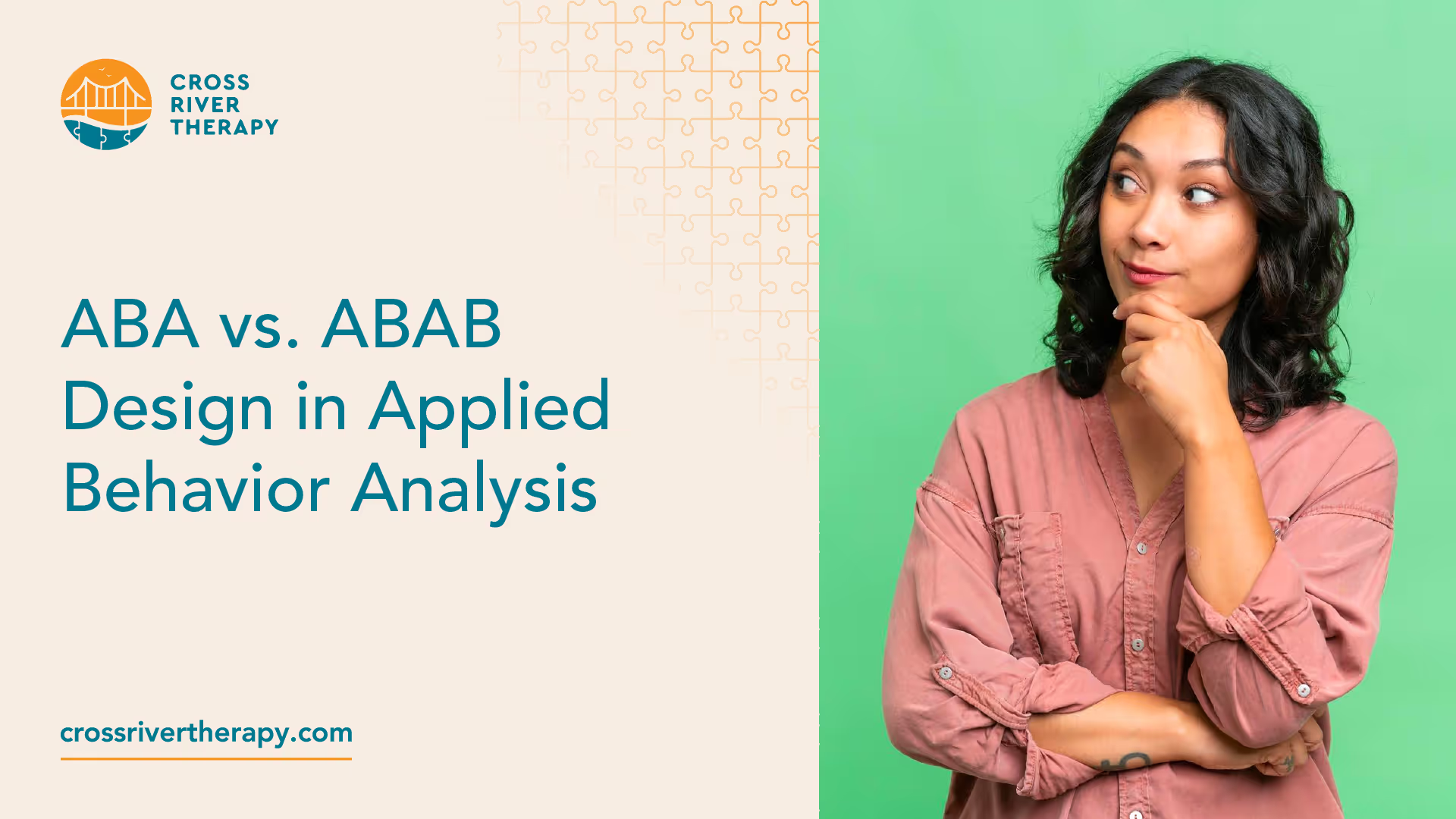ABA vs. ABAB Design in Applied Behavior Analysis
Learn the difference between ABA and ABAB design.

ABA vs. ABAB Design: Main Differences

What is ABAB design?
When trying to understand ABAB design, it is essential to know that the design involves two parts but each part of the design is revisited in the treatment.
The first part of the ABAB design is where the analyst gathers the baseline information on the behavior they are trying to change.
They apply a treatment and then measure the effects of the treatment chosen.
The second part of the ABAB design deals with the baseline measurement that was established to see what happens once the treatment is removed and then reapplied to the treatment and how the measurement has changed in the process. The basic breakdown of the ABAB design is as follows:
- First A: Attempts to measure the client's baseline behavior
- First B: Provides a treatment measurement for the behavior
- Second A: Takes away the treatment
- Second B: Re-introduces the treatment to the client
One that is important to understand about the ABAB design is that it can be used on more than one subject at the same time, and each subject could experience different treatment.
This might add more As and Bs to the design, but the design will still stick to the two basic parts described above.
One important thing you should remember is if the analyst chooses to go further and add more As and Bs, this design will always end with a "B", which will reintroduce the intervention rather than withdrawing it, leaving them without.
What is ABA design?
ABA therapy is one of the more common treatment methods that behavior analysts use with people with autism.
It involves using positive reinforcement to help modify behavioral issues that many autistic people experience and deal with. The first A in the ABA design is when the analyst takes the time to observe the client and establish their baseline.
This is important because not everyone's baseline for behaviors will be the same. The first "A" stands for the unaltered behavior or the baseline.
The next step is the "B", which is when the analysts use an intervention to try and help modify the undesired behavior.
An example of this would be for a child who needs a structured schedule, the analysts might introduce a task chart as their intervention method to help the child. If the child follows the chart, they will be offered a reward for their efforts.
This will help to modify the behavior positively. The intervention used is the "B" in the ABA design. Finally, the last "A" is the step when the analyst will remove the intervention to see if it is having a positive effect.
As per the example above, the analyst would remove the task chart and provide the child with instruction to see how they respond and if the intervention was working as it was intended to.
It is important to realize that with the ABA design method the intervention will be removed from the scenario, and if it doesn't work, the process will start over from scratch with a new intervention idea.
What is the difference between ABA and ABAB design?
The ABA design is used when the analyst wants to provide stronger evidence that the treatment they have chosen was an effective one. Plus, they alter the initial behavior with intervention and then have that intervention withdrawn to see if the baseline the analyst set up is returned to once it has been withdrawn.
Whereas, the ABAB design reintroduces the intervention method after the behavior has returned to the baseline to be able to properly judge the strength of the type of intervention that the analyst chose to use.
Simply, the ABAB design helps to solve problems of behavior by adding a benefit and then taking it away to return to the baseline to see what changes. The ABA design provides stronger evidence of how a used treatment has an effect.
Why is an ABAB design better than an ABA design?
There are many opinions on which design is better ABA or ABAB, and the answer might vary depending on who you ask.
Many ABA therapists believe that the ABAB design can be counterintuitive because it withdrawals an effective treatment. Why would you take away something if it is working to give you the desired effect?
Well, the simple answer is that when you take away the intervention and then reinduce it in the future, the intervention generally works faster the second time. If you think about it logically, it does make sense. If there is something that you like and then it is taken away, if you know that you can get it back you will do that thing faster because you already know that you will like what you get if you do.
Plus, with the ABAB design method, the process ends on a "high note", which means that it will end with the intervention in place and present rather than being withdrawn.
This method can also be repeated as many times as it takes with the sequence. With the ABA design method, there is a single reversal method, and this is oftentimes not strong enough to be considered effective, especially when working with people with autism who might not pick up on things quickly.
However, with the ABAB design method, the analyst can repeat the process several times to help the client understand and feel more comfortable with the intervention rather than just having it taken away, like in the ABA design model.
Both of these design methods have their pros and cons, but according to many ABA therapists, the ABAB design method is often chosen because it provides them with more information and can help by providing them with the intervention that best works rather than having to restart the process all over again.
Recent News
Related articles

Working With Autistic Children: 10 Career Options
Want to work with autistic children? Here are 10 career options for you to consider.

What Is The Age Limit For ABA Therapy In Indiana?
Find out what the age limit is for receiving Applied Behavior Analysis (ABA) therapy in Indiana.

What Is The Age Limit For ABA Therapy In Arizona?
Find out what the age limit is for receiving Applied Behavior Analysis (ABA) therapy in Arizona.

Verbal Operants In ABA: Definition & Examples
In Applied Behavior Analysis, verbal operants are a type of verbal behavior.

Token Economy: Examples & Applications in ABA
A token economy is a procedure that was developed to help reduce maladaptive behaviors and increased desire behaviors by providing a tangible conditioned reinforcer.

Trigger Analysis In ABA: Definition & Examples
Trigger analysis is a segment of ABA therapy where children are taught by therapists to pinpoint the behaviors and emotions that happen before, during, and after an event that takes place.

Variable Ratio Schedule & Examples
A variable-ratio schedule is a random reinforcement where responses are reinforced following varied responses afterward.

Task Analysis In ABA Therapy: Examples & Strategies
Task analysis is a process of teaching that divides complicated activities into sections involving easier steps for students to more easily take.

Stimulus Equivalence In ABA: Definition & Examples
Stimulus equivalence shows how relationships can manifest among different types of stimuli in different situations.

Speech Therapy For Autism: ABA vs. Speech Therapy
ABA therapy can help individuals with speech impairments learn to better identify and utilize the language skills they already have.

Stimulus Control Transfer ABA: Definition & Examples
Stimulus control is defined as an expression used to detail circumstances where a behavior is triggered by the existence or absence of a stimulus.

Social Validity In ABA: Definition & Examples
Social validity is the acceptance of interventions concerning behavioral changes.

